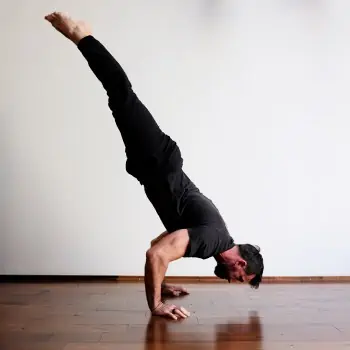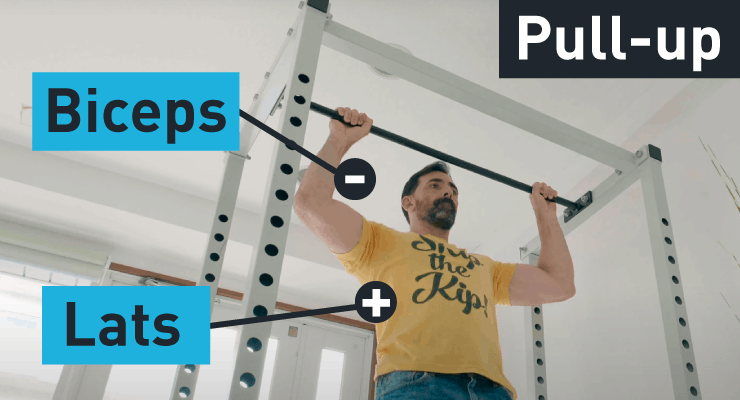Should you do chin-ups or pull-ups? That is the question.
In short, we think starting off with the chin-up is ideal. But there are some differences you should know about before getting started. This way, you’ll get the most out of each movement and make progress quickly and safely.
The Difference Between Chin-Ups And Pull-Ups
It all comes down to hand placement.

With pull-ups, your hands are in a pronated position. To visualize this, hold your hands out in front of you and then turn your palms to the floor.
One way to remember the difference is ‘pull-ups’ start with a ‘p’ and therefore, your grip is in the pronated position. P for pronated.
And for chin-ups, your hands are in a supinated position, which means your palms are facing upward.
Hold your hands out in front of you and then turn your palms to the sky. This is the supinated position.

Get 16 Proven Strength Tutorials
We’ll send you our best methods and progressions for building practical strength, yours free.
Muscles Worked In The Chin-Up And Pull-Up
To be clear, both movements work similar muscle groups; lats, traps, biceps, and forearms. The grip will determine the extent of how much each muscle group is worked. And both movements require you to keep your core nice and tight.
For pull-ups, you are afforded a wider range in grip position. We recommend placing your hands right outside of shoulder-width. And because your hands are in the pronated position, you will get more activation in your lats and less in your biceps. This is because your biceps are in a less-advantageous position to pull your body weight up to the bar.

👉 Check out our full pull-up tutorial for detailed tips.
But for chin-ups, your palms are facing upward. We recommend your grip to be right about shoulder-width apart.
Your biceps’ primary function is elbow flexion, and this puts you in a position to engage your arms more when doing this movement. So if you want to work your arms a bit harder (in addition to your lats), chin-ups are a good option.

Should You Do Chin-Ups Or Pull-Ups?
We think you should begin with chin-ups because they’re the easier variation of the movement. This is because you get more bicep activation, which aids in your ability to pull yourself up.
Mastering this movement will transfer to other pulling movements as well. Once you can do a single, super slow, full chin-up, you’ll be ready to work on your pull-ups.
Here’s our breakdown on chin-ups vs. pull-ups.
By the way, if you’re not quite ready or don’t have the equipment to get started with chin-ups, here’s some bodyweight back exercises you can do at home.
Oh… Skip The Kip, Please
For real. They might look cool when you see someone doing them in so-called perfect form but they are chock full of downsides… mostly a massive risk of injury, and little to no benefit for building strength and control over your body.
Plus, the kipping pull-up is solely for CrossFit competition. So unless you’re planning on competing, it’s best to avoid these.

As you can probably imagine by what you see above… the kipping pull-up can be hard on your shoulder joints, and potentially your entire body if things get ugly like they did for our boy Skip.
Performance And Joint Health
As you now know, the main difference between pull-ups and chin-ups is your grip. And your grip determines how far your hands are from each other, as well as the musculature you’re working.
When doing chin-ups, it’s important to keep your hands no wider than shoulder width because it can cause unnecessary strain on your elbows the wider your grip becomes. This is due to the line of pull. You want your elbows to be in line with your wrists from start to finish.
If you ever experience elbow pain, check out our guide on improving your elbows’ health, strength, and mobility.
With pull-ups, you’re afforded the ability to spread your hands out wider because of your hand position. Because your hands are pronated, your elbows naturally flare outward. When doing the movement, your elbows stay in line with your wrists, which is ideal for keeping your elbows and shoulders happy.
Chin-Up Vs. Pull-Up Commonly Asked Questions
What's a better movement? Chin-ups or pull-ups?
Are chin-ups easier than pull-ups?
Why can I do chin-ups but not pull-ups?
Is it OK to do pull-ups daily?
What muscles do chin-ups work?
Build Strength For Every Day Living
Chin-ups and pull-ups are foundational strength movements. And they take a lot more focus and practice than picking up a pair of dumbbells and doing curls for bigger guns.
Being able to pull your body up to a bar translates to other areas of life and play… whether that be kayaking, martial arts, or getting better at handstands. When you want more strength, you can’t go wrong with improving your pulling ability. And we show you how to do that with our 8-week program, Integral Strength.
Use Skill-Based Training to Build Practical Strength
Integral Strength is a skill-based strength program that helps you build practical skills and strength that carry over into your beloved daily activities.


